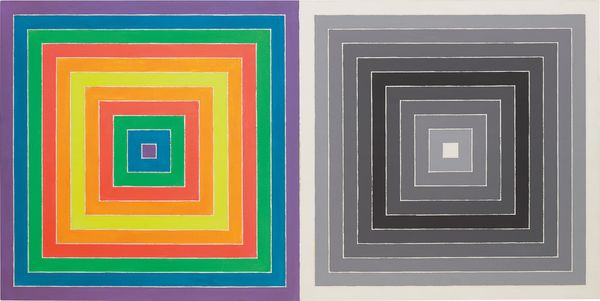Frank Stella WLID, 1967. Estimate: £2,000,000-3,000,000.
20th Century & Contemporary Art Evening Sale at Phillips London, 13 February.
Alternating between gray tones and fluorescent values, WLID, 1967, is a sublime example of Frank Stella’s body of Concentric Squares, which the artist commenced in 1961. In the present work, divided into two sections, Stella has employed white, black, and various shades of gray to compose a multitude of squares on the right side of the canvas, and a kaleidoscopic array of colors to erect its refracted twins on the left, altogether forming an immersive and tonally dynamic image. "In the 'double concentric' pictures, the values of the successive hues [do] not directly correspond to the values of the gray bands that constituted their mirror-image counterpart," wrote William Rubin. "What the eye [does] distinguish, however, was the commonality of their progressive sequence – a sequence so obvious that it seemed to have been done 'by the numbers' according to Stella" (William Rubin, Frank Stella: 1970-1987, exh. cat., Museum of Modern Art, New York, 1987, p. 48).
The concentric square format is about as neutral and as simple as you can get. It's just a powerful pictorial image.
— Frank Stella
Like Stella’s earlier Black, Aluminium and Copper paintings, the artist’s square compositions articulate the relationship between the two-dimensional picture plane and its three-dimensional support. However, unlike previous colorless formulations, the Concentric Squares are characterized by a crisp regularity, rigid symmetry and all-over flatness. "These pictures have a kind of immediacy that was not to be found in the more complex structures, the more elusive and ambiguous light and the more painterly execution of the Black, Aluminum and Copper pictures" (William Rubin, Frank Stella: 1970-1987, exh. cat., The Museum of Modern Art, New York, 1987, n.p.). In its conflation of color and grayscale, WLID embodies the stylistic transition Stella underwent in the 1960s, moving away from the sole use of black and instead delving into a wider specter of chromes. Three years after the execution of the work, the artist was given a retrospective at The Museum of Modern Art, New York, making him the youngest artist ever to receive this recognition, at the age of 33.
The artist in his New York City studio on 15 November 1967.
© Frank Stella. ARS, NY and DACS, London 2020.
Image: David Gahr/Getty Images.
Coming from an academic background – Stella was described as "extraordinarily intelligent," "precocious" and "exceedingly well-schooled" – the artist was taught and encouraged by the legendary teacher Stephen Greene at Princeton University before being skyrocketed to fame by his Black Paintings at the end of the 1950s (Peter Schjeldahl, "Big Ideas," The New Yorker, 9 November 2015, online). As Stella’s chief concern was composition, the concentric square came swiftly afterward, constituting for him an ideological watershed. "The concentric square format is about as neutral and as simple as you can get," the artist said. "It's just a powerful pictorial image. It's so good that you can use it, abuse it, and even work against it to the point of ignoring it. It has a strength that's almost indestructible – at least for me" (Frank Stella, quoted in William Rubin, Frank Stella 1970-1987, exh. cat., Museum of Modern Art, New York, 1987, p. 43).
Employing an exacting methodology whereby each cubic ring is painted in flat, unmixed and saturated color, Stella creates minute arrangements that seemingly radiate from the center outwards. It appears almost a magical feat that the artist should have composed WLID by applying paint straight from the tube onto the canvas; yet, it is precisely Stella’s painstaking process that distinguishes his output from that of anyone else’s, and his near-perfect result from a truly sleek, uncompromised image. There is something very matter-of-fact about Stella’s work, which delectably echoes the discipline with which he realizes his Concentric Squares. "I like to make paintings, and I work at that: it’s my job. I don’t consider myself that different from anybody else. So I live in the real world and while I’m living in it, I’ll be more or less like other people. I don’t worry about that. I worry about the paintings… the drive to make art" (Frank Stella, quoted in William Rubin, Frank Stella: 1970-1987, exh. cat., Museum of Modern Art, New York, 1987, p. 8).

